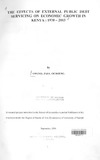| dc.description.abstract | Kenya has been receiving aid from donor community for over three decades now. The need to service a large amount of external debt has led to “crowding-out” of investment besides reducing the country’s credit worthiness internationally (World Bank, 2004). With a lot of money being spent on debt servicing, the Kenyan economy has plunged into a deficit and recession and has thus affected investment growth negatively. The Kenya government has hence had no other options but to borrow domestically to finance its budget deficit. This has increased the total public debt and resulted in low levels of investment leading to low economic growth in the recent past. Past empirical studies on debt in Kenya have not addressed the issue of debt servicing specifically and usually tend to deal with effects of debt in general for example Elbadawi and Ndungu, 1996 and Were, 2001.
The study set out to establish the effects of external public debt servicing on economic growth in Kenya and the magnitude, .size and structure of Kenya’s external debt. To
t
achieve these objectives the study used time series data for 33 years in regressing a GDP growth rate equation. The time series data for the GDP growth rate and the stock of external debt to GDP lagged by one period, debt service as a ratio of export earnings, lagged fiscal deficit to the GDP ratio, current real private investment as a ratio of GDP, public investment as a ratio of GDP, terms of trade, rate of inflation, interest rates were obtained from Policy Timeline and Time Series Data for Kenya (Ryan, T.C.I. 2004).
Before the regression was done, an analysis of the stationarity for all variables was done which revealed that though the variables such as real GDP growth rate, debt service as a ratio of exports and inflation were stationary at 5 percent level of significance, the rest were
stationary at the first difference.These were, stock of external debt to GDP, private investment as a ratio of GDP, public investment as a ratio of GDP, terms of trade and interest rates.
Estimation results showed that indeed debt servicing affects economic growth and thus increase in the debt servicing leads to a decrease in the GDP growth rate. The study also found out that both public and private investments have a great impact on the GDP growth rate. | en_US |

